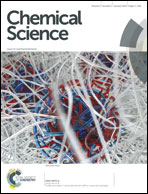Nucleation and growth of mercury on Pt nanoelectrodes at different overpotentials†
Abstract
Three-dimensional nucleation and growth on active surface sites are fundamentally important initial stages of electrodeposition of metals. Electrodeposition of Hg is a widely employed model for studies of such processes because the near-ideal hemispherical growth of its liquid nuclei can be used to check the existing theory. In this article we discuss nucleation/growth of Hg at 50–100 nm radius Pt electrodes. Recently, atomic force microscopy (AFM) was used to demonstrate that a nanoelectrode of this size has a single active site for Ag nucleation, at which the growth of a single nucleus was monitored (Chem. Sci., 2012, 3, 3307). Here we report similar observations for Hg nucleation/growth at relatively low overpotentials (e.g., 25 to 75 mV). However, at higher overpotentials (e.g., ≥100 mV), the kinetics of this process changed, and very fast multiple nucleation of Hg was observed. Possible origins of this phenomenon are discussed.


 Please wait while we load your content...
Please wait while we load your content...